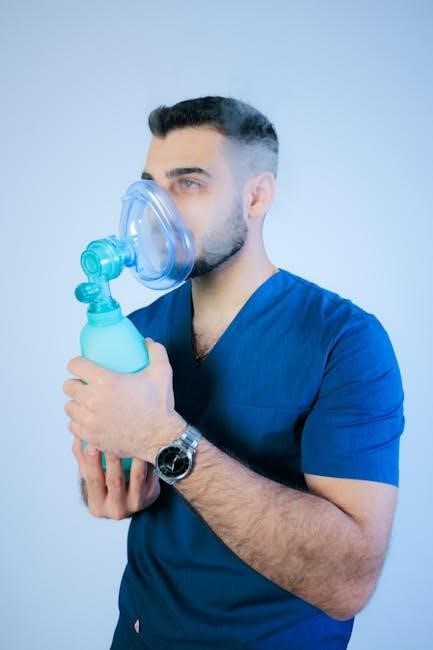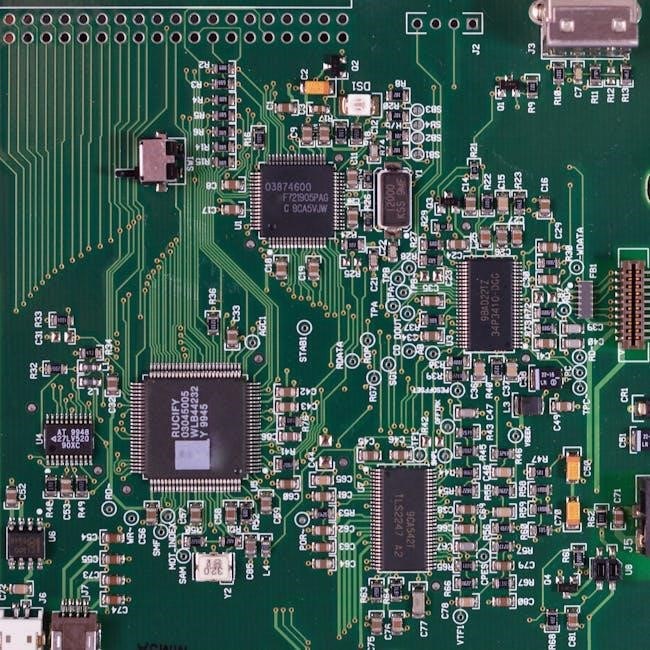The respiratory system is vital for oxygen intake and carbon dioxide expulsion, enabling life-sustaining processes. Understanding its functions and health is crucial for overall well-being and disease prevention.
Overview of the Respiratory System

The respiratory system is a complex network of organs and tissues responsible for breathing, ensuring oxygen is absorbed into the bloodstream and carbon dioxide is expelled. It includes the nose, mouth, trachea, bronchi, and lungs. The process begins with inhalation, where air enters the nostrils or mouth, passes through the pharynx, and moves into the larynx before reaching the trachea. The trachea splits into bronchi, which branch into smaller bronchioles within the lungs, ultimately leading to alveoli, where gas exchange occurs. Oxygen diffuses into the bloodstream, while carbon dioxide is expelled during exhalation. This system is vital for maintaining cellular function and overall health. Understanding its mechanics and care is essential for preventing and managing respiratory disorders, which are among the most common health issues worldwide.

Importance of Understanding Respiratory Health
Understanding respiratory health is critical for maintaining overall well-being and preventing diseases. The respiratory system’s proper function ensures adequate oxygen supply to cells and organs, supporting metabolic processes and energy production. Respiratory health issues, such as infections or chronic conditions, can significantly impact quality of life and productivity. Knowledge of respiratory health enables early detection of symptoms, timely medical interventions, and effective management of conditions like asthma or chronic obstructive pulmonary disease (COPD). Additionally, awareness of environmental hazards, such as air pollution or occupational exposures, can prevent respiratory damage. Educating individuals about respiratory health promotes healthier lifestyles, reduces healthcare costs, and improves public health outcomes. Prioritizing respiratory health is essential for living a longer, healthier life and mitigating the burden of respiratory diseases globally.
Structure of the Respiratory System

The respiratory system consists of airways, lungs, and breathing muscles, forming a complex network for gas exchange. Its design ensures efficient oxygen absorption and carbon dioxide removal.
Upper Respiratory Tract
The upper respiratory tract includes the nose, mouth, pharynx (throat), and larynx (voice box). It serves as the entry point for air and plays a critical role in filtering, warming, and humidifying the air we breathe. The nose contains tiny hairs called cilia and mucus-producing cells that trap dust, bacteria, and other pathogens, preventing them from entering the lungs. The pharynx acts as a passageway for both air and food, while the larynx houses the vocal cords and ensures that food does not enter the trachea. The upper respiratory tract also contains lymphoid tissues, such as the tonsils and adenoids, which help defend against infections. This system is essential for maintaining respiratory health and preventing illnesses that could affect the lower respiratory tract. Understanding its structure and function is key to managing and treating respiratory disorders effectively.
Lower Respiratory Tract
The lower respiratory tract consists of the trachea, bronchi, bronchioles, and lungs, functioning primarily in gas exchange. The trachea divides into bronchi, which branch into smaller bronchioles leading to alveoli, tiny air sacs where oxygen diffuses into the bloodstream and carbon dioxide is expelled. The lungs are protected by the ribcage and supported by the diaphragm, which facilitates breathing. This system is lined with cilia and mucus to trap pathogens, preventing infections. The lower respiratory tract is more susceptible to severe infections compared to the upper tract, as it directly involves oxygen exchange. Understanding its structure and function is vital for diagnosing and managing conditions like pneumonia or chronic obstructive pulmonary disease (COPD). Proper care and protection of the lower respiratory tract are essential for maintaining overall respiratory health and preventing life-threatening illnesses.
Key Organs and Their Functions
The respiratory system comprises several key organs, each with distinct roles. The nose and mouth serve as entry points for air, while the pharynx directs it to the trachea. The trachea, or windpipe, leads to the bronchi, which branch into smaller bronchioles within the lungs. The lungs contain alveoli, tiny sacs where gas exchange occurs—oxygen diffuses into the bloodstream, and carbon dioxide is expelled. The diaphragm, a muscular sheet, contracts to expand the chest cavity, enabling inhalation.Accessory muscles, such as those in the neck and abdomen, assist during labored breathing. Together, these organs ensure efficient respiration, maintaining oxygen supply and waste removal. Understanding their functions helps in identifying potential issues and promoting respiratory health. Proper functioning of these organs is vital for overall well-being and preventing respiratory disorders.

Common Respiratory Infections
Common respiratory infections, such as COVID-19, influenza, and RSV, are prevalent and can have a significant impact on the respiratory system’s functionality and overall health.
Upper Respiratory Infections (URIs)
Upper respiratory infections (URIs) are common and affect the upper airways, including the nose, throat, sinuses, and larynx. They are typically caused by viruses such as rhinoviruses, coronaviruses, and respiratory syncytial virus (RSV). Symptoms include nasal congestion, sneezing, sore throat, and coughing, often accompanied by a low-grade fever. URIs are highly contagious and spread through respiratory droplets or contact with contaminated surfaces. Most URIs are self-limiting and resolve within 7–10 days without treatment. However, in severe cases or for high-risk individuals, such as young children or those with weakened immune systems, complications like sinusitis or ear infections may develop. Practicing good hygiene, such as frequent handwashing and avoiding close contact with infected individuals, can help reduce the spread of URIs.
Lower Respiratory Infections (LRIs)
Lower respiratory infections (LRIs) involve the lower airways, primarily the trachea, bronchi, and lungs. Common types include bronchitis and pneumonia. These infections are often caused by bacteria, viruses, or fungi. Symptoms typically include coughing, shortness of breath, chest tightness, and fever, which can range from mild to severe. LRIs are more serious than URIs and may lead to complications such as bronchiectasis or chronic obstructive pulmonary disease (COPD) in vulnerable populations. Accurate diagnosis is crucial, often requiring chest X-rays or lab tests. Treatment varies depending on the cause but may involve antibiotics, antiviral medications, or supportive care like oxygen therapy. Preventive measures include vaccinations and avoiding exposure to respiratory irritants or pathogens. Understanding LRI symptoms and seeking timely medical care can prevent severe outcomes and improve recovery rates.
Respiratory Syncytial Virus (RSV)
Respiratory Syncytial Virus (RSV) is a highly contagious virus that primarily affects the respiratory system. It is a common cause of lower respiratory infections, particularly in infants, young children, and older adults. RSV infections typically occur seasonally, with peaks during colder months. Symptoms often mimic those of the common cold, including coughing, sneezing, and runny nose, but can progress to more severe conditions like bronchiolitis or pneumonia in vulnerable populations. Diagnosis is usually through clinical evaluation and laboratory tests such as PCR. Treatment focuses on managing symptoms, with severe cases requiring hospitalization and supportive care like oxygen therapy. Preventive measures include good hygiene practices, avoiding close contact with infected individuals, and immunoprophylaxis for high-risk groups. Understanding RSV transmission and taking preventive steps can significantly reduce its impact, especially in those most susceptible to complications.

Respiratory Protection and Safety
Respiratory protection is vital in workplaces and confined spaces to prevent inhalation of harmful substances. Online resources offer guidance for managers to ensure breathing safety and mitigate risks effectively.

Workplace Respiratory Hazards
Workplace respiratory hazards include dust, chemicals, and fumes that can cause severe health issues. Industries like construction, mining, and manufacturing often face such risks. Confined spaces and poorly ventilated areas exacerbate these dangers, making breathing safety a critical concern. Employers must implement safety measures, such as proper ventilation and personal protective equipment (PPE), to minimize exposure. Online resources and guidelines are available to help managers address these challenges effectively, ensuring a safer environment for workers. Regular training and adherence to safety protocols are essential to prevent long-term respiratory damage and maintain employee well-being in hazardous settings.
Personal Protective Equipment (PPE)
Personal Protective Equipment (PPE) is essential for safeguarding respiratory health in hazardous environments. Respirators, face masks, and filters are critical components of PPE, designed to filter out harmful particles and pathogens. Proper selection and fitting of respirators ensure maximum protection, preventing inhalation of dust, chemicals, and infectious agents. Training on PPE usage is vital to enhance effectiveness and compliance. Regular maintenance and replacement of PPE components are necessary to uphold their protective capabilities. Employers should provide accessible resources and guidelines to educate workers on PPE best practices, ensuring a safer workplace and reducing respiratory risks. By adhering to PPE protocols, individuals can effectively mitigate exposure to airborne hazards, safeguarding their respiratory and overall health.
Confined Space Safety Measures
Confined spaces pose significant respiratory risks due to potential oxygen deficiency or hazardous atmospheres. Safety measures include proper ventilation, air quality testing, and use of respiratory PPE. Training and emergency preparedness are crucial. Ensuring safe entry and exit procedures minimizes risks. Monitoring air quality continuously helps prevent unexpected hazards. Communication devices and rescue plans are essential for emergencies. Employers must enforce strict protocols to protect workers. Regular audits and updates to safety measures ensure compliance with regulations, safeguarding respiratory health in confined environments.
